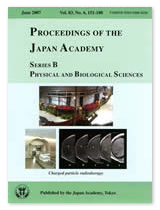About the Cover
Vol. 83 No. 6 (2007)
The Hyogo Ion Beam Medical Center (HIBMC) is located in Hyogo Prefecture, adjacent to the world famous 3rd generation synchrotron radiation facility, SPring-8. In 1992 the HIBMC was built as the world's first institution where both proton and carbonion radiotherapy could be performed. Both the treatment facilities and the hospital opened in 2001. Since then, more than 1,400 cancer patients have been treated in the HIBMC by February 2007. The main accelerator is a synchrotron with a diameter of 30 meters which produces protons (70-230 MeV/μ) and carbon-ions (70-320 MeV/μ) (upper figure). There are 5 treating rooms and the lower left figure shows a proton radiotherapy room. The rotating gantry can deliver protons to a tumor from any angle. Therefore, a tumor can be irradiated with minimized radiation damage to adjacent normal tissues.
Protons or carbon-ions are far superior to X- or γ-rays in localizing the radiation doses to the target tumor mass because of their forming a Bragg peak. In addition, carbon-ions are nearly twice as effective as X- or γ-rays in killing cancer cells. It is expected, therefore, that those ion beams can cure early stage tumors with minimum damages to normal tissues and eradicate even some kinds of tumors in an advanced stage. The lower right figure shows an example of proton radiotherapy for liver cancer. The patient was an 81-year-old female with hepatocellular carcinoma. Before the treatment, the tumor (arrow) was about 7 cm in diameter (a) but its size was reduced gradually with the progress of the treatment (b-d). The tumor disappeared three months after proton radiotherapy with a total dose of 76 GyE/20fr./4w (e). The patient is alive more than five years after the treatment with no evidence of recurrence. As shown in this case, proton or carbon-ion radiation therapy provides cancer patients with a new treatment modality without serious invasion and adverse effects. Patients can be treated in a relaxed atmosphere.




